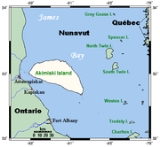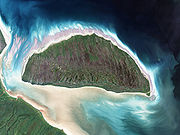
Akimiski Island
Encyclopedia
Akimiski Island is the largest island in James Bay
(a southeasterly extension of Hudson Bay
), Canada
, which is part of the Qikiqtaaluk Region of the territory of Nunavut
. It has an area of 3001 km² (1,158.7 sq mi), making it the 163rd largest island in the world, and Canada's 29th largest island. Akimiski Island is only 19 km (11.8 mi) from the province of Ontario
. From the western side of the island, one can see the Ontario coastline.
 The island currently has no year-round human inhabitants; however, it is part of the Attawapiskat First Nation
The island currently has no year-round human inhabitants; however, it is part of the Attawapiskat First Nation
's traditional territory and is frequently used for traditional purposes. The surface of Akimiski is flat and slopes gradually to the north. Most of the vegetation that covers the island consists of lichen
, moss
, sedges, and dwarf Black Spruce
. The island is a coastal wetland that includes mudflat
s, tidal marshes, and tidal mudflat
s. Freshwater streams that flow into southwestern James Bay carry sediments and abundant nutrients that help to sustain the productive waterfowl habitat around Akimiski Island.
The Akimiski Island Group includes Akimiski, Gasket, and Gullery Islands; Albert Shoal; and Akimiski Strait Isles.
, site #NU036 (53°10′12"N 081°19′48"W). Its eastern portion is also a federal Migratory Bird Sanctuary, and much of the coastline is a Key Migratory Bird Terrestrial Habitat site
.
James Bay and Hudson Bay are funnel-shaped and consequently cause migrating birds from the Arctic to concentrate in this area. During fall migration, there is an abundance of birds when adults and young are present. In the springtime, the birds tend to reside in the southern areas of James Bay until the northern section thaws.
James Bay
James Bay is a large body of water on the southern end of Hudson Bay in Canada. Both bodies of water extend from the Arctic Ocean. James Bay borders the provinces of Quebec and Ontario; islands within the bay are part of Nunavut...
(a southeasterly extension of Hudson Bay
Hudson Bay
Hudson Bay , sometimes called Hudson's Bay, is a large body of saltwater in northeastern Canada. It drains a very large area, about , that includes parts of Ontario, Quebec, Saskatchewan, Alberta, most of Manitoba, southeastern Nunavut, as well as parts of North Dakota, South Dakota, Minnesota,...
), Canada
Canada
Canada is a North American country consisting of ten provinces and three territories. Located in the northern part of the continent, it extends from the Atlantic Ocean in the east to the Pacific Ocean in the west, and northward into the Arctic Ocean...
, which is part of the Qikiqtaaluk Region of the territory of Nunavut
Nunavut
Nunavut is the largest and newest federal territory of Canada; it was separated officially from the Northwest Territories on April 1, 1999, via the Nunavut Act and the Nunavut Land Claims Agreement Act, though the actual boundaries had been established in 1993...
. It has an area of 3001 km² (1,158.7 sq mi), making it the 163rd largest island in the world, and Canada's 29th largest island. Akimiski Island is only 19 km (11.8 mi) from the province of Ontario
Ontario
Ontario is a province of Canada, located in east-central Canada. It is Canada's most populous province and second largest in total area. It is home to the nation's most populous city, Toronto, and the nation's capital, Ottawa....
. From the western side of the island, one can see the Ontario coastline.

Attawapiskat First Nation
Attawapiskat First Nation is an isolated First Nation located in Kenora District in northern Ontario, Canada, at the mouth of the Attawapiskat River at James Bay...
's traditional territory and is frequently used for traditional purposes. The surface of Akimiski is flat and slopes gradually to the north. Most of the vegetation that covers the island consists of lichen
Lichen
Lichens are composite organisms consisting of a symbiotic organism composed of a fungus with a photosynthetic partner , usually either a green alga or cyanobacterium...
, moss
Moss
Mosses are small, soft plants that are typically 1–10 cm tall, though some species are much larger. They commonly grow close together in clumps or mats in damp or shady locations. They do not have flowers or seeds, and their simple leaves cover the thin wiry stems...
, sedges, and dwarf Black Spruce
Black Spruce
Picea mariana is a species of spruce native to northern North America, from Newfoundland west to Alaska, and south to northern New York, Minnesota and central British Columbia...
. The island is a coastal wetland that includes mudflat
Mudflat
Mudflats or mud flats, also known as tidal flats, are coastal wetlands that form when mud is deposited by tides or rivers. They are found in sheltered areas such as bays, bayous, lagoons, and estuaries. Mudflats may be viewed geologically as exposed layers of bay mud, resulting from deposition of...
s, tidal marshes, and tidal mudflat
Mudflat
Mudflats or mud flats, also known as tidal flats, are coastal wetlands that form when mud is deposited by tides or rivers. They are found in sheltered areas such as bays, bayous, lagoons, and estuaries. Mudflats may be viewed geologically as exposed layers of bay mud, resulting from deposition of...
s. Freshwater streams that flow into southwestern James Bay carry sediments and abundant nutrients that help to sustain the productive waterfowl habitat around Akimiski Island.
The Akimiski Island Group includes Akimiski, Gasket, and Gullery Islands; Albert Shoal; and Akimiski Strait Isles.
Climate
- Mean annual temperature: 2.5 °C (36.5 °F)
- Average rainfall: 450 mm (17.72 in)
- Average snowfall: 250 mm (9.84 in)
Conservation
Akimiski Island is a Canadian Important Bird AreaImportant Bird Area
An Important Bird Area is an area recognized as being globally important habitat for the conservation of bird populations. Currently there are about 10,000 IBAs worldwide. The program was developed and sites are identified by BirdLife International...
, site #NU036 (53°10′12"N 081°19′48"W). Its eastern portion is also a federal Migratory Bird Sanctuary, and much of the coastline is a Key Migratory Bird Terrestrial Habitat site
Key Habitat Site
A Key Habitat Site is a Canadian Wildlife Service designation for an area that supports at least 1% of the country's population of any migratory bird species, or subspecies, at any time. There may be overlap with areas designated as a migratory bird sanctuary or national wildlife area.-External...
.
Fauna
The coastal waters and wetlands of Akimiski Island (and James Bay in general) are important feeding grounds for many varieties of migratory birds. Notable species include:- Atlantic Brant
- Canada GooseCanada GooseThe Canada Goose is a wild goose belonging to the genus Branta, which is native to arctic and temperate regions of North America, having a black head and neck, white patches on the face, and a brownish-gray body....
- Lesser Snow GooseSnow GooseThe Snow Goose , also known as the Blue Goose, is a North American species of goose. Its name derives from the typically white plumage. The genus of this bird is disputed...
- Marbled GodwitMarbled GodwitThe Marbled Godwit, Limosa fedoa, is a large shorebird. On average, it is the largest of the 4 species of godwit. The total length is , including a large bill of , and wingspan is . Body mass can vary from ....
- Semipalmated SandpiperSemipalmated SandpiperThe Semipalmated Sandpiper, Calidris pusilla, is a very small shorebird. It is sometimes separated with other "stints" in Erolia but although these apparently form a monophyletic group, the present species' old genus Ereunetes had been proposed before Erolia.Adults have black legs and a short stout...
James Bay and Hudson Bay are funnel-shaped and consequently cause migrating birds from the Arctic to concentrate in this area. During fall migration, there is an abundance of birds when adults and young are present. In the springtime, the birds tend to reside in the southern areas of James Bay until the northern section thaws.
External links
- NASA Photo : "STS085-713-070 Akimiski Island, Northwest Territory, Canada August 1997 Akimiski Island, a 2000-square-mile (5180 square kilometers) uninhabited island, is the largest island in James Bay (a southeasterly extension of Hudson Bay)."

